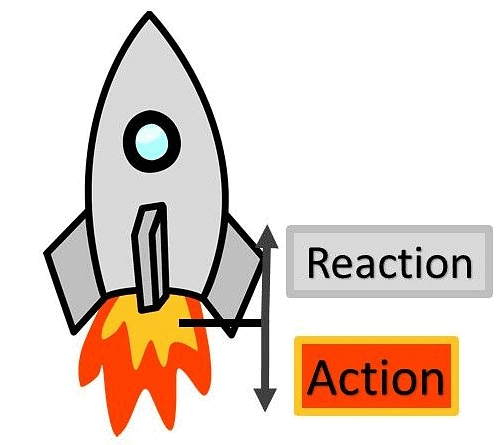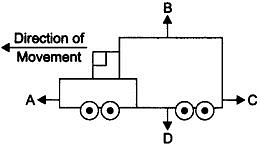Class 9 Science Chapter 8 Question Answers - Force and Laws of Motion
Ques 1: Define force.
Ans: It is a push or pull on an object that produces acceleration in the body on which it acts.
Ques 2: What is the S.I. unit of force?
Ans: The S.I. unit of force is Newton.
Ques 3: Define one Newton.
Ans: A force of one Newton produces an acceleration of 1 m/s2 on an object of mass 1 kg.
1 N = 1 kg m/s2
Ques 4: What is balanced force?
Ans: When forces acting on a body from the opposite direction do not change the state of rest or of motion of an object, such forces are called balanced forces.
Ques 5: What is frictional force?
Ans: The force that always opposes the motion of an object is called the force of friction.
Ques 6: What is inertia?
Ans: The natural tendency of an object to resist a change in its state of rest or of uniform motion is called inertia.
Ques 7: State Newton’s first law of motion.
Ans: An object remains in a state of rest or of uniform motion in a straight line unless acted upon by an external unbalanced force.
Ques 8: State Newton’s second law of motion.
Ans: The rate of change of momentum of an object is proportional to the applied unbalanced force in the direction of the force.
Ques 9: What is momentum?
Ans: The momentum of an object is the product of its mass and velocity and has the same direction as that of the velocity. The S.I. unit is kg m/s. (p = mv)
Ques 10: State Newton’s III law of motion.
Ans: For every action, there is an equal and opposite reaction, and they act on two different bodies.
Ques 11: Which will have more inertia, a body of mass of 10 kg or a body of mass of 20 kg?
Ans: A body of mass 20 kg will have more inertia.
Ques 12: Name the factor on which the inertia of the body depends.
Ans: The inertia of a body depends upon the mass of the body.
Ques 13: Name two factors that determine the momentum of a body.
Ans: Two factors on which the momentum of a body depends are mass and velocity. Momentum is directly proportional to the mass and velocity of the body.
Ques 14: What decides the rate of change of momentum of an object?
Ans: The rate of change of momentum of an object is proportional to the applied unbalanced force in the direction of force.
Ques 15: The diagram shows a moving truck. Forces A, B,
C and D are acting on the truck.
Name the type of forces acting on a truck.
Ans: The forces A, B, C and D acting on the truck are:
A → driving force
B → reacting force
C → frictional force
D → weight/gravitational force
Short Answer Type Questions
Ques 1: State the difference between balanced and unbalanced force.
Ans:
| Balanced force | Unbalanced force |
| Forces acting on a body from opposite directions are the same. | Forces acting on a body from two opposite directions are not the same. |
| It does not change the state of rest or motion of an object. | It does change the state of rest or of motion of an object. |
Ques 2: What change will force bring in a body?
Ans: Force can bring the following changes in the body:
It can change the speed of a body.
It can change the direction of motion of a body,
It can change the shape of the body.
Ques 3: When a motorcar makes a sharp turn at a high speed, we tend to get thrown to one side. Explain why?
Ans: It is due to the law of inertia. When we are sitting in a car moving in a straight line, we tend to continue in our straight-line motion. But when the engine applies an unbalanced force to change the direction of motion of the motorcar. We slip to one side of the seat due to the inertia of our bodies.
Ques 4: Explain why it is dangerous to jump out of a moving bus.
Ans: While moving in a bus, our body is in motion. On jumping out of a moving bus, our feet touched the ground and came to rest. The upper part of our body stays in motion and moves forward due to the inertia of motion, and hence, we can fall in the forward direction.
Hence, to avoid this, we need to run forward in the direction of the bus.
Ques 5: Why do fielders pull their hands gradually with the moving ball while holding a catch?
Ans: While catching a fast-moving cricket ball, a fielder on the ground gradually pulls his hands backward with the moving ball. This is done so that the fielder increases the time during which the high velocity of the moving ball decreases to zero. Thus, the acceleration of the ball is decreased, and therefore, the impact of catching the fast-moving ball is reduced.
Ques 6: In a high jump athletic event, why are athletes made to fall either on a cushioned bed or on a sand bed?
Ans: In a high jump athletic event, athletes are made to fall either on a cushioned bed or on a sand bed so as to increase the time of the athlete’s fall to stop after making the jump. This decreases the rate of change of momentum and, hence, the force.
Ques 7: How does a karate player break a slab of ice with a single blow?
Ans: A karate player applied the blow with large velocity in a very short interval of time on the ice slab, which therefore exerted a large amount of force on it and suddenly broke the ice slab.
Ques 8. Why are roads on mountains inclined inwards at turns?
Ans: A vehicle moving on mountains is in the inertia of motion. At a sudden turn, there is a tendency for the vehicle to fall off the road due to a sudden change in the line of motion; hence, the roads are inclined inwards so that the vehicle does not fall down the mountain.
Ques 9: For an athletic race, why do athletes have a special posture with their right foot resting on a solid supporter?
Ans: Athletes have to run the heats, and they rest their feet on solid supports before the start so that during the start of the race, the athlete pushes the support with a lot of force and this support gives him equal and opposite push to start the race and get a good start to compete for the race.
Ques 10: Why do you think it is necessary to fasten your seat belts while traveling in your vehicle?
Or
How are safety belts helpful in preventing any accidents?
Ans: While we are traveling in a moving car, our body remains in a state of rest with respect to the seat. But when the driver applies sudden breaks or stops the car, our body tends to continue in the same state of motion because of its inertia. Therefore, this sudden break may cause injury to us by impact or collision. Hence, the safety belt exerts a force on our body to make the forward motion slower.
Ques 11: When you kick a football, it flies away, but when you kick a stone, you get hu why?
Ans: This is because stone is heavier than football, and heavier objects offer larger inertia.
When we kick a football, its mass is less, and inertia is also less, so the force applied by our kick acts on it, and hence, it shows larger displacement, but in the case of stone, it has a larger mass and offers larger inertia. When we kick (action) the stone, it exerts an equal and opposite force (reaction), and hence it hurts the foot.
Ques 12: If a person jumps from a height on a concrete surface, he gets hurt. Explain.
Ans: When a person jumps from a height, he is in a state of inertia of motion. When he suddenly touches the ground, he comes to rest in a very short time, and hence, the force exerted on his body by the hard concrete surface is very high, and the person gets hurt.
Ques 13: What is the relation between Newton’s three laws of motion?
Ans: Newton’s first law explains the unbalanced force required to bring change in the position of the body.
The second law states/explains the amount of force required to produce a given acceleration.
And Newton’s third law explains how these forces acting on a body are interrelated.
Ques 14: Give any three examples in daily life that are based on Newton’s third law of motion.
Ans: Three examples based on Newton’s third law are :
(i) Swimming: We push the water backward to move forward.
action – water is pushed behind
reaction – water pushes the swimmer ahead
(ii) Firing gun: A bullet is fired from a gun and the gun recoils.
action – gun exerts a force on the bullet
reaction – bullet exerts an equal and opposite force on the gun
(ii) Launching of rocket: action – hot gases from the rocket are released. Reaction – the gases exert an upward push on the rocket
Ques 15: A bullet of m.ass 20 g is horizontally fired with a velocity of 150 m/s from a pistol of mass 2 kg. What is the
recoil velocity of the pistol?
Ans:

Total momentum of the pistol and bullet before firing, when the gun is at rest
= m1u1 + m2u2
= (0.02 * 0) + (2 * 0)
0 kg m/s
Total momentum of the pistol and bullet after it is fired
= m1v1 + m2v2
= (0.02 kg * 150) + (2 kg * v)
= 3+ 2v
∴ Total momentum after firing = Total momentum before firing
3 + 2v
∴ v = -3/2 = -1.5 m/s
|
88 videos|369 docs|67 tests
|
FAQs on Class 9 Science Chapter 8 Question Answers - Force and Laws of Motion
| 1. What are the three laws of motion? |  |
| 2. What is inertia? |  |
| 3. What is the unit of force? |  |
| 4. Explain the concept of action and reaction in Newton's third law of motion. |  |
| 5. How does mass affect the acceleration of an object? |  |

|
Explore Courses for Class 9 exam
|

|


















